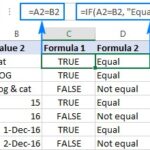Floating-point numbers are efficient for numerical computations, but they can lead to unexpected results when compared directly due to representation errors. This article explains why these errors occur and how to accurately compare floats in Python.
 Python Float Comparison
Python Float Comparison
A common example highlighting this issue is:
>>> 0.1 + 0.2 == 0.3
FalseThis seemingly incorrect result stems from how floating-point numbers are stored in binary format. Decimal values like 0.1, 0.2, and 0.3 often have repeating binary representations, leading to rounding errors when stored as floats.
Understanding Floating-Point Representation Error
The conversion from base-10 decimal to base-2 binary introduces rounding errors for many common decimal values. This happens because fractions that terminate in decimal may have repeating representations in binary. For instance, 0.1 in decimal is 0.000110011… in binary, a repeating fraction. Due to finite memory, the computer truncates this infinite representation, leading to a slightly inaccurate stored value.
This rounding error, known as floating-point representation error, is widespread and affects not only equality comparisons but also other comparisons like greater than or less than.
The math.isclose() Solution
To reliably compare floats in Python, avoid direct equality checks using ==, <=, or >=. Instead, utilize the math.isclose() function:
>>> import math
>>> math.isclose(0.1 + 0.2, 0.3)
Truemath.isclose() determines if two floating-point numbers are “close enough” by considering a defined tolerance. It checks if the absolute difference between two numbers is less than a calculated threshold based on relative and absolute tolerances.
The default relative tolerance (rel_tol) is 1e-09, meaning numbers are considered close if their difference is within 0.00000001% of the larger magnitude. An absolute tolerance (abs_tol), defaulting to 0.0, handles comparisons involving zero. You can adjust these tolerances as needed.
When to Use math.isclose()
Use math.isclose() whenever comparing floating-point values for equality. For comparisons involving <= or >=, handle the equality case separately using math.isclose() and then perform the strict inequality check.
Alternatives for Precise Numerical Representation
For scenarios demanding absolute precision, Python offers Decimal and Fraction types. Decimal handles decimal numbers exactly with user-definable precision, while Fraction represents rational numbers as exact fractions, eliminating representation errors inherent to floats. However, these types come with performance overhead compared to floats.
Conclusion
Comparing floating-point numbers directly can yield inaccurate results due to representation errors. Using math.isclose() ensures reliable comparisons by considering acceptable tolerances. For absolute precision, leverage Decimal or Fraction types. Understanding these nuances is crucial for writing robust numerical code in Python.

